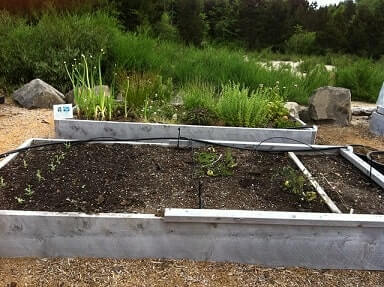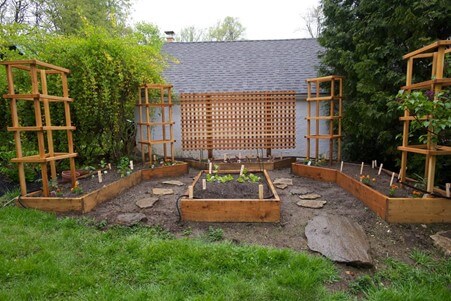Life will be perfect if the earth provides all the water plants need.
But that is impossible to happen, and it is our responsibility to keep our favorite plants and vegetables happy by providing them the water they require to thrive.
To have a healthy garden, you must understand and follow the raised bed watering solutions listed below.
Raised bed gardens are ideal for growing herbs, plants, fruits, and vegetables in your backyard.
They are easy to install and provide consistency and even watering to the plants. The best feature about these raised garden beds is that they do not require much maintenance after installation.
The method you follow to water these raised beds creates the main difference between a thriving garden full of happy plants and a struggling garden where plants are either under-watered or over-watered.
Tips to Water the Raised Beds Effectively
1. Weather Is Important for Plants
If the question arises in your mind, does weather affect plants? The answer is yes! The high or shallow temperature of a plant can be a bit harmful.
However, there is still some disparity related to temperature stress in plants.
Some plants begin to wilt whenever a temperature rises, while others have a robust resistive tendency and are at their best even in extreme conditions.
Plant growth is affected by high temperatures in numerous ways.
The high temperatures mainly affect photosynthesis, in which plants produce oxygen using carbon dioxide and sunlight.
Photosynthesis is the opposite of respiration, which humans and animals perform.
When there is an uncomfortable rise in the temperature, both these processes become unbalanced.
Plants require more water in the summer heat and when it is dry or windy.
During the summer, hot areas such as Arizona require watering raised beds even twice a day. In other seasons, raised water beds may only require one- or two times watering a week.
If you have an automatic watering system, you adjust the timer’s frequency according to the weather conditions.
So, it would help to focus on the weather while following any raised bed watering solutions.
- SIMPLE and EFFECTIVE: Gouevn Soil moisture meter only for testing soil moisture, basic model works...
- INDOOR AND OUTDOOR USE: A super helpful tool for your garden, Yard, lawn, Farm, potted plants....
- SIMPLIFIED YOUR LIFE: Accurate and easy to read, When you have a lot of houseplants, you don't have...
- NO BATTERY REQUIRED, LIGHTWEIGHT: Compact and portable, Gouevn plant water meter no batteries or...
2. You Should Be Aware of The Watering Needs of Plants
Water is one of the most important things almost every living being needs.
Watering a plant is not difficult, but how much and how often to water is a little tricky. The plant cells are like water balloons.
When the plant cells are filled with water, they become stiff, and plants stand upright. But whenever water is lacking, these cells deflate, and the plant looks wilted.
So, water pressure and cellulose are mainly responsible for maintaining the shape of the plants.
It would help if you remember that soil is like a sponge. Most houseplants like a porous texture of the soil, allowing sufficient room for air pockets and water.
Observe the soil before watering. If it is a bit moist, you can hold off watering.
If the water pours out immediately through the drainage holes in a raised waterbed, then this means the soil is bone dry and it is repelling water.
This will not let the water reach the roots of your plants.
You should continuously monitor plants for any signs of under-watering.
As explained earlier, these signs include brown, dry edge leaves, leaf curls, and slow growth.
Although, sometimess plants wilt in the afternoon but recover by morning, this is mainly because of heat stress, and there is no role of water stress.
In most cases, it is how a plant prevents moisture loss through its leaves.
Overwatering plants is also not good, and you should allow plants to become a bit heat-tolerant by not overwatering them.
The signs that you are overwatering your raised garden bed are rotten and soft roots, constant wet soil, and yellowish-green leaf growth.
Inconsistent watering also causes these problems.
- WOOD MOISTURE METER: Prevent water and moisture build-up with our humidity reader. It can quickly...
- PROTECT YOUR WORK SURFACE: This tool has no pins, so it won't mar, scratch, or damage walls. It...
- DEEP READER: It can read the levels up to 3/4" (19mm) deep into the surface with a broad measurement...
- MOLD DETECTOR: Early prevention is vital when stopping mold formation. Check and test suspicious...
3. Water More Deeply Rather Than More Frequently
Whichever raised bed watering solution you follow, the water must reach your plants’ roots.
Healthy root growth is not possible if water does not reach the entire root system of your plant, so you avoid shallow watering.
You can keep a soil probe (any long metal object such as a screwdriver) to check the watering depth.
If the device moves smoothly inside the soil, it means the plant bed needs no further watering, but if there is some resistance in its movement, it means that the plant needs additional watering.
You can also use a moisture meter to measure the moisture level.
For example, it would help if you waited for the top inch of the soil to dry out before you water your raised garden bed again.
You can occasionally water twice as long to flush excess salts from the soil.
If you do not have any particular device to monitor soil moisture, do not worry. Your hands are simple enough for the job.
If you feel that the soil is slightly damp or spongy to the touch, it means it does not need further watering.
Don’t get deceived by the surface; you should check the root zone of your raised gardening bed (3″ inches or deep) with your finger.
- GARDENING GLOVES SPECIALLY FOR WOMEN - Lightweight & breathable knitted base for a comfortable fit....
- DURABLE & VERSTILE - Soft but sturdy foamed latex coating reduces fatigue. Non-slip grip gloves...
- SAVE YOUR TIME & MONEY - Pair of 6. Great value bundle package for garden yard keeper, worker. Easy...
- PERFECT GLOVES FOR GARDENERS - Coating in bright colors make them easier to find in your garden. A...
4. Water Plants in The Morning
The best time to water plants is early morning when it is cool. This is because less water is lost through evaporation, and the water reaches the roots easily by running down the soil.
Another benefit of watering in the morning is that water is available for the plant throughout the day; this helps plants deal better with the heat produced by the sun.
There is a myth that watering in the morning makes the plants more susceptible to scorch.
Firstly, almost every corner of the earth does not receive enough sunlight for water droplets to scorch the plants.
Secondly, even if you live in any area that receives a lot of heat, the water droplets will evaporate due to heat before they can focus sunlight and scorch plants.
Sometimes, watering the garden in the morning is difficult due to life and work schedules.
In this case, you can water your garden in the late afternoon or early evening.
One important thing you should remember while watering plants in the evening is that there should be enough sun to dry the soil a bit before night.
Excess water dampens leaves, encouraging fungus problems like sooty mold and mildew.
If you are using a drip or soaker irrigation system, you do not need to worry about this problem; leaves do not get wet in watering.
- This micro drip irrigation kit is suitable for an area of 160 square feet. You can water all your...
- The new garden watering system design 4x6-Way CONNECTOR can divide the water up to 16 tributaries,...
- MIXC micro drip irrigation kit comes with 3 types of sprayer, the drip emitter can adjust different...
- Automatic irrigation kit is great for atomization, lawn irrigation, patios, roof cooling,...
5. Consistent and Even Watering Is Required for a Raised Garden Bed
The best solution among raised bed watering solutions is to use any automatic watering system to water your plants.
The best feature about these systems is that they have timers. These timers can be adjusted to water the plants according to the season and the weather.
Timers can be easily calibrated to water the plants daily during the hottest months of the year or less frequently, depending on rain.
Consistency is also important in watering because inconsistent watering causes several problems.
Such as drying out of seeds and seedlings; this further stresses an established plant, which can invite many plant diseases.
- Planter Size: 83"L x 35"W x 12"H
- Planter Volume: 17.83 Cu. Ft.
- Suitable for planting vegetables、flowers and plants in your courtyard.
- Made of galvanized metal plate, wave structure and oval shape.
Best Automatic Watering System
Many automatic watering systems are available in the market, making watering raised plant beds a no-brainer.
They include soaker hoses, drip lines attached to a timer, and sprinklers.
However, of these three methods, drip-line irrigation is the most effective among raised waterbed solutions.
1. Soaker hoses
The garden hose is a unique system that efficiently waters your raised bed garden.
The water seeps out slowly through the tiny pores present along the length of the rubber hose at a particular flow rate.
This allows plants to absorb the right amount of moisture.
By this method, water quickly reaches the root zone without any excess water pressure. Another benefit of this method is that the water is delivered to the roots.
This keeps the foliage dry and reduces the chances of any fungal infection.
Note that drip irrigation systems are different from soaker houses.
2. Sprinklers
Sprinklers can be used in large, raised plant beds. However, there are many disadvantages associated with sprinklers.
Firstly, they can be quite wasteful, as they use a large amount of water, and almost 50% of it is evaporated on hot and windy days before it reaches the roots.
Secondly, they encourage many fungal diseases that thrive on wet foliage and can easily be transmitted.
The main advantage of these sprinklers is that they are less expensive as compared to other options, and the amount of water as well as it is sprayed on can be adjusted.
- Made of high quality plastic, stable and durable
- The main water supply can be connected directly to the butterfly nozzle
- Good sealing effect, suitable for vegetable, fruit tree, shrub, nursery and other crops irrigation
- Depending on the water pressure, the jet will form a distant, drizzle shape, just like a light rain,...
3. Drip Lines
Drip lines are a system of tubing and nozzles that supply water exactly to the point that it needs it.
Drip line irrigation system requires some initial planning to install, but they conserve water by providing it only to the parts of the bed that need it.
The water flow rate in these drip lines is also slow, which prevents water loss through evaporation.
If you live in an area where water is scarce, or use of it is restricted, then a drip irrigation system is surely best for you.
The drip line system is constructed using flexible plastic drip hose tubing with tiny holes that spray or drip water slowly on the soil.
The drip line is surely one of the best-raised bed watering solutions.
- 【✅Extremely flexible】- Our distinctive drip tube is built from a special polymer blend that...
- 【✅Extremely durable】- Built to handle any environment and weather. Abrasion resistant material...
- 【✅Small Irrigation System】- Used as the main line in a small Drip irrigation system or to...
- 【✅Narrow Area Suitable】- Ideal for small, narrow and tight planting areas, as well as areas...
According to the Soil Type: Choose the Watering Method

The different types of soil have different capacities to hold water.
Clay-based soil easily holds onto the water as each clay particle has a lot of surface area for water to attach.
Sandy soil is generally avoided for raised gardening beds because it has bigger particles than clay soil.
Sandy soil lets the water pass easily through it and, hence, does not retain moisture.
Loamy soil is also a good option for a raised bed garden as it retains some moisture yet is well-drained.
A method by which you can improve soil’s ability to hold water is by adding compost to it.
This way, you supply just the right amount of water to the plant. Sandy soil without compost is like a basket of golf balls; water passes easily.
When you add compost to the soil, it is like adding sponges to the soil. Water still runs through it, but some are stored in sponges.
Compost improves the quality of sandy and clay soil by aerating them and providing better drainage.
Final Thoughts
In conclusion, successful watering in raised bed gardens hinges on understanding and adapting to both the environmental conditions and the unique needs of your plants.
Key strategies include monitoring weather patterns, recognizing the signs of under and over-watering, and choosing the right watering method based on soil type.
Implementing a more efficient watering system, like drip irrigation or soaker hoses, can significantly enhance the health and yield of your garden.
Moreover, adding compost to the soil not only improves its quality but also its water retention capability, which is crucial for both sandy and clay soils.
Remember, consistency in watering and being present to oversee the process are essential to catch any issues early.
By following these guidelines and paying close attention to the specific needs of your garden, you can ensure that your raised beds remain a thriving, productive, and joyful part of your outdoor space.









